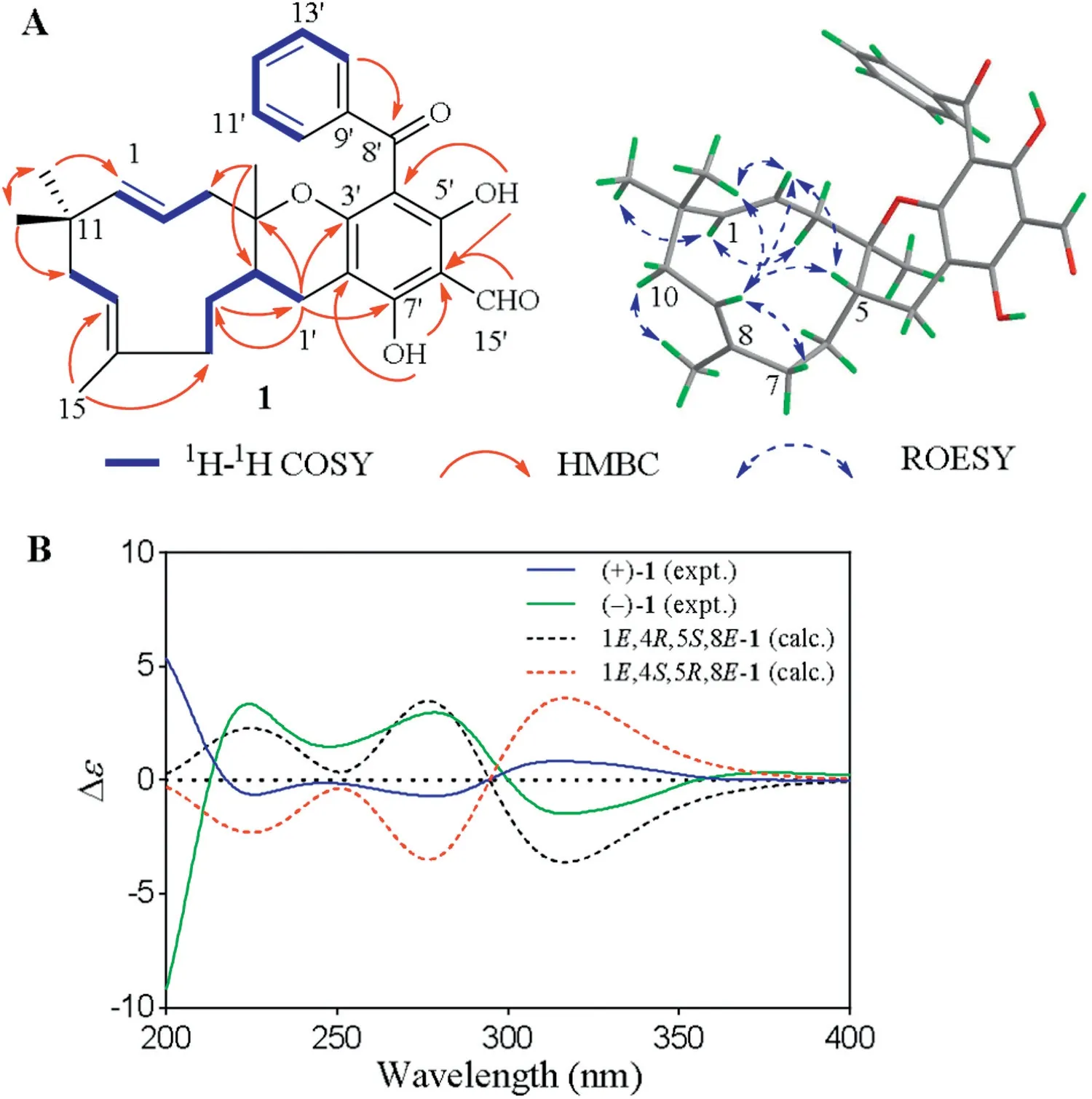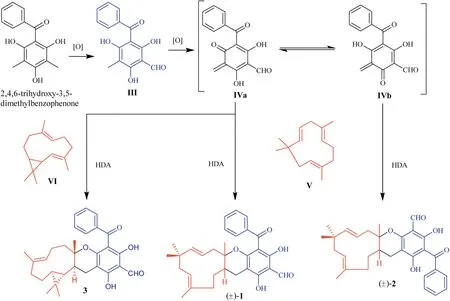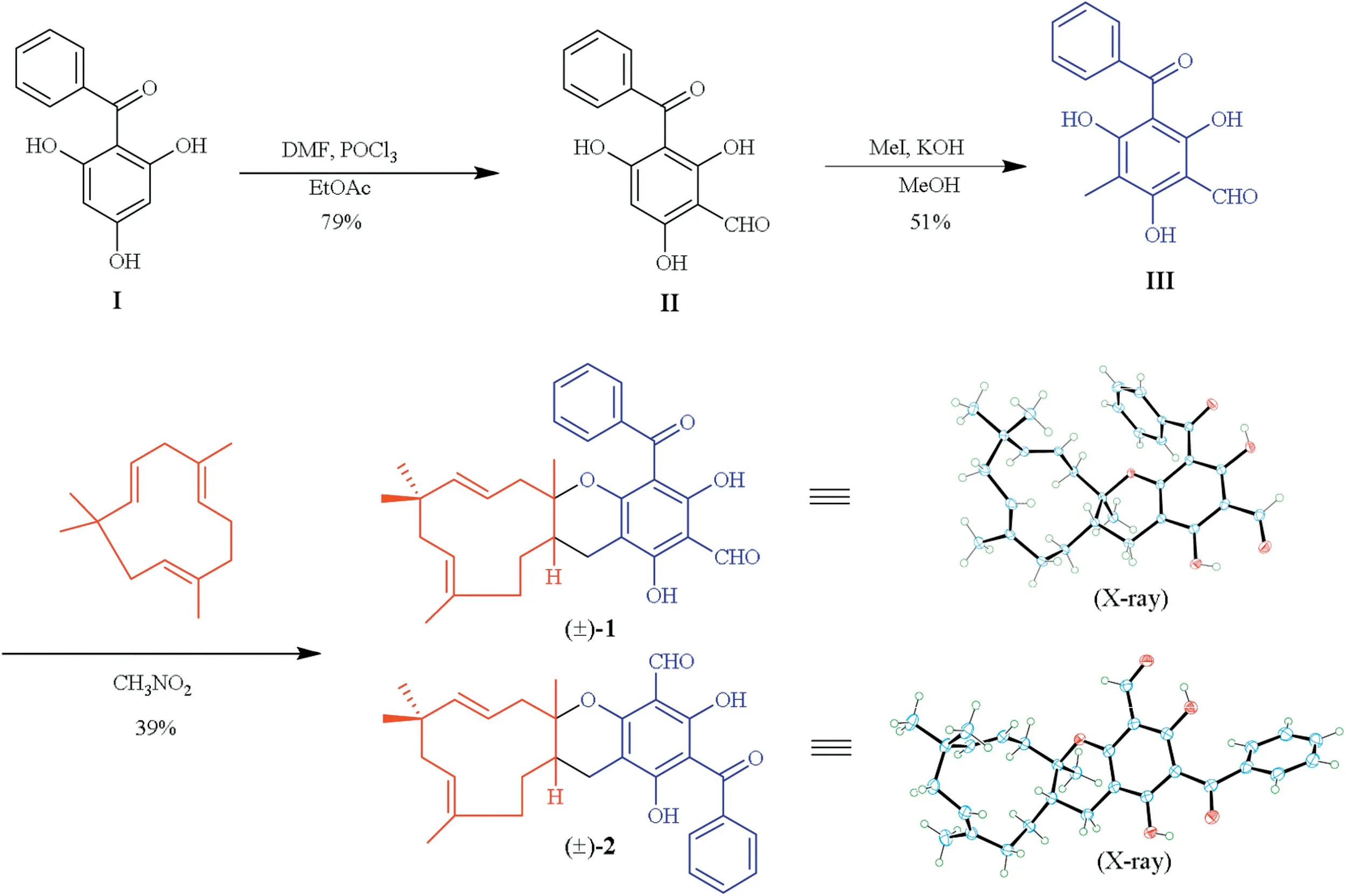Psiguamers A-C,three cytotoxic meroterpenoids bearing a methylated benzoylphloroglucinol framework from Psidium guajava and total synthesis of 1 and 2
2021-11-06JiwuHuangChuangjunLiJieMaYingdaZangXingyanSunXiaoguangChenDongmingZhang
Jiwu Huang,Chuangjun Li,Jie Ma,Yingda Zang,Xingyan Sun,Xiaoguang Chen,Dongming Zhang*
State Key Laboratory of Bioactive Substance and Function of Natural Medicines, Institute of Materia Medica, Chinese Academy of Medical Sciences and Peking Union Medical College, Beijing 100050, China
ABSTRACT Three sesquiterpene-based meroterpenoids psiguamers A-C (1-3) with new skeletons were isolated from Psidium guajava leaves.Compounds (±)-1 and (±)-2 were two pairs of humulene-derived meroterpenoids bearing a rare methylated benzoylphloroglucinol unit, while 3 was an unprecedented adduct of bicyclogermacrene and methylated benzoylphloroglucinol.Their structures were determined based on comprehensive analyses of spectroscopic data, calculated electronic circular dichroism (ECD)spectra,total synthesis,and X-ray crystallographic data.The biomimetic synthesis of(±)-1 and(±)-2 was achieved.Compound (+)-1 exhibited cytotoxic activities against five human tumor cell lines (HCT-116,HepG2, BGC-823, A549, and U251), with IC50 values of 2.94, 9.01, 6.45, 5.42, and 5.33 μmol/L,respectively.
Keywords:Psidium guajava Methylated benzoylphloroglucinol Meroterpenoids Biomimetic synthesis Cytotoxic activities
Psidium meroterpenoids,a group of intricate molecules that are part terpenoids,part natural phloroglucinol,possess a wide range of interesting bioactivities.Modern pharmacological investigations showed meroterpenoids from P.guajava leaves exhibited significant bioactivity,such as hepatoprotective,anti-inflammatory, anticancer, and protein tyrosine phosphatase 1B (PTP1B)inhibitory activity [1-4].Structurally, according to the phenolic moiety, Psidium meroterpenoids can be classified as two groups,formyl-benzyl phloroglucinol and methylated benzoylphloroglucinol types [5,6].Among these meroterpenoids,most of them are caryophyllane or cadinane derived meroterpenoids with a 3,5-diformyl-benzyl phloroglucinol unit [7-9].However, methylated benzoylphloroglucinol meroterpenoids were rarely reported, and only caryophyllane type was found since 2015 [2,5,6].Herein, we first report humulene and bicyclogermacrene derived methylated benzoylphloroglucinol meroterpenoids from the leaves of Psidium guajava.Compounds (±)-1 and (±)-2 were two pairs of unprecedented humulene derived meroterpenoids with a 6/6/11 ring system, and 3 was an unusual bicyclogermacrene derived meroterpenoid with a 6/6/10/3 ring framework(Fig.1).Moreover,the total synthesis of(±)-psiguamer A(1)and(±)-psiguamer B(2)was achieved, and all the isolates were evaluated for their cytotoxicity.

Fig.1.Chemical structures of compounds 1-3.
(±)-Psiguamer A (1) was obtained as a white amorphous powder with the molecular formula C30H34O5,determined by the(-)-HRESIMS ion peak at m/z of 473.2335 [M-H]-(Calcd.for 473.2334)with an index of hydrogen deficiency of 14.The1H NMR data (Table 1) showed two hydrogen-bonded phenolic hydroxyls(δH13.72 (s,1H) and 13.28 (s,1H)), an aldehyde group (δH10.25(s,1H)),a monosubstituted benzene ring(δH7.37-7.45(5H)),three alkene protons(δH4.95(dd,J=4.2,12.0 Hz,1H),4.92(d,J=15.6 Hz,1H), and 4.56 (ddd, J=2.4, 10.8, 15.6 Hz, 1H)) and four methyl groups(δH1.55,1.01,0.99,and 0.92(each,s,3H)).The13C NMR and DEPT spectra presented a total of 30 carbon signals, including a ketone carbonyl (δC200.4), a conjugated aldehyde (δC192.2), a hexasubstituted benzene ring (δC168.8,167.3,162.3,104.3,103.8,and 100.8),a monosubstituted benzene ring((δC142.5,130.2,127.9(×2),and 126.5(×2)),four olefinic carbons(δC142.4,136.4,123.1,and 119.9), four methyl (δC30.2, 24.4, 19.8, and 17.1), five methylene (δC41.7, 41.3, 37.5, 30.1, and 22.0), one methine, one quaternary, and one oxygenated tertiary carbons.The above data indicated that 1 was a sesquiterpene-based meroterpenoid.

Table 1 1H NMR (600 MHz) and 13C NMR (150 MHz) spectroscopic data for compounds 1-3 (δ in ppm, CDCl3).
The1H-1H COSY spectrum (Fig.2A) showed cross peaks for H-1/H-2/H-3, H-1′/H-5/H-6/H-7, and H-9/H-10 coupling systems.The HMBC spectrum(Fig.2A)revealed correlations from H3-12 to C-1,C-10,and C-13,from H3-13 to C-1,C-10,and C-12,from H3-14 to C-3 and C-5, and from H3-15 to C-7 and C-9, indicating the presence of a humulene moiety.Similarly, the presence of 3-methyl-5-formyl-benzoyl phloroglucinol unit(1a)was determined by a series of HMBC cross signals from H-1′to C-3′and C-7′,from H-10′and H-14′to C-8′, from H-5′-OH to C-4′and C-6′, from H-7′-OH to C-2′and C-6′, and from H-15′to C-6′.The humulene moiety and 1a were linked through the C-5-C-1′bond,as indicated by HMBC correlations from H-1′to C-4 and C-6, and from H-6 to C-1′.Moreover, the oxygenated tertiary carbon C-4 (δC84.8) and the downfield chemical shift of C-3′(δC162.3)connecting with an index of hydrogen deficiency of 14 demonstrated that a dihydropyran ring connecting the humulene moiety and 1a.
The relative configuration of 1 was determined by its rotatingframe overhauser spectroscopy (ROESY) NMR spectrum (Fig.2A)and proton coupling constants.The ROESY correlations between H-1 and H-3a,between H-2 and H3-13 revealed the E-geometry of the C1/C2 double-bond, which was consistent with the large coupling constant that was observed (JH1-2=15.6 Hz).The E-geometry of the C8/C9 olefin was determined by the ROESY correlations between H-9 and H-7b, between H3-15 and H-10a.Furthermore, ROESY correlations between H-2 and H-5, between H-5 and H-9, and between H-9 and H-2 demonstrated that H-2,H-5,and H-9 were on the same side of the molecule,while H-1 and H3-15 were on the opposite side.Two peaks were found in the chiral HPLC analysis of 1,indicating that 1 was a racemic mixture.Consequently, a cellulose-4 chiral column was used to separate 1and afforded (+)-1 and (-)-1.Their absolute configurations were determined by comprehensive analysis of the experimental and calculated electronic circular dichroism(ECD)spectra(Fig.2B)of 1.The experimental ECD spectra of (+)-1 and (-)-1 were high consistent with the computed ECD data of 1E,4S,5R,8E-1 and 1E,4R,5S,8E-1, respectively.Thus, (+)-psiguamer A [(+)-1] and(-)-psiguamer A [(-)-1] were established.

Fig.2.(A) Selected 2D correlations of 1.(B) Experimental and calculated ECD spectra of (+)-1 and (-)-1.
(±)-Psiguamer B(2)was isolated as a white amorphous powder with a molecular formula C30H34O5,as determined by 1D NMR and the (+)-HRESIMS ion peak at m/z of 475.2481 [M+H]+(Calcd.for C30H35O5at 475.2479).Comparing its13C NMR data with those of(±)-psiguamer A(1)revealed that compound 2 was an isomer of 1,only differing at C-5′(δC166.8 in 2,168.8 in 1),C-6′(δC102.9 in 2,104.3 in 1), C-7′(δC169.4 in 2,167.3 in 1), and C-9′(δC140.8 in 2,142.5 in 1),indicating the location of phenyl unit of 2 was not the same as that of 1.The position of phenyl ring was assigned by HMBC spectrum (Fig.S2.9 in Supporting information), in which H-10′was correlated with C-8′, H-15′with C-4′and C-5′,H-5′-OH with C-4′and C-6′, and H-7′-OH with C-2′and C-6′.The relative configuration of 2 was established by the NOESY NMR spectrum(Fig.S2.10 in Supporting information).Two peaks were observed in the chiral HPLC analysis of 2, suggesting that 2 was a racemic mixture,which was applied to a cellulose-4 chiral column to yield(+)-2 and (-)-2.
The absolute configurations of(+)-2 and(-)-2 were established via ECD calculation.Compound 1E,4S,5R,8E-2 was selected for the conformational analysis via Conflex 8B software at the MMF94S force field.The two lowest-energy conformers 2A and 2B(Fig.S2.11 in Supporting information)were selected for optimization with the TDDFT method at the B3LYP/6-31 G level in CH3CN with the CPCM(conductor-like polarizable continuum model)using the Gaussian 16 program.Due to the flexibility of the semi-chiral axis (C6′C8′),conformers 2A and 2B differed in the orientation of the monosubstituted benzene ring, which was consistent with the previously report [5].Furthermore, a Boltzmann weight of approximately 1:1 for 2A and 2B led to a total cancellation between π→π* and n→π* transitions of 1a.Thus, the overall computed ECD spectrum of 2 demonstrated minor Cotton effects(CEs) at 240-400 nm.However, the calculated ECD spectra of 2A and 2B presented similar CEs at approximately 211 nm(produced by the π→π* transition of Δ1(2)), which contributed to an overall positive signal.Therefore,the stereo configuration of (+)-2 can be established by comparing the CEs of the experimental ECD at 211 nm with calculated ECD.The experimental ECD of (+)-2(Fig.S2.12 in Supporting information) qualitatively matches the computed ECD spectrum of 1E,4S,5R,8E-2, suggesting that the steroconfiguration of (+)-psiguamer B [(+)-2] is 1E,4S,5R,8E.The absolute configuration of (-)-psiguamer B [(-)-2] was similarly established as 1E,4R,5S,8E.
Psiguamer C (3), colorless oil, had a molecular formula of C30H34O5based on its (+)-HRESIMS ion peak at m/z of 497.2304[M+Na]+(Calcd.forC30H34O5Na,497.2298).Detailedcomparisonof its1H and13C NMR data with those of literatures suggested compound 3 was an adduct of 1a and a germacrene moiety as eucalteretialA[10].In1H-1HCOSY spectrum(Fig.S3.7inSupporting information), correlation between H-6 and H-1′suggested a C-6-C-1′coupling pattern in 3, which was further confirmed by HMBC correlations from H-14 to C-6,from H-6 to C-1′and C-2′,and from H-1′to C-5,C-7,and C-3′(Fig.S3.9 in Supporting information).The NOESY correlations (Fig.S3.10 in Supporting information)betweenH3-15 and H-3b,betweenH-2 and H-10b suggested that an E-geometry of the C1/C2 olefin.The NOESY correlations of H-7/H-8,H-7/H3-14,and H3-14/H-1′suggested these protons were co-facial.Finally, the absolute configuration of 3 was established as 1E,5S,6S,7R,8S by comparing the experimental and calculated ECD spectra(Fig.S3.11 in Supporting information).
Biosynthetic pathways for compounds 1-3 are proposed in Scheme 1.2,4,6-Trihydroxy-3,5-dimethylbenzophenone,α-humulene (V), and bicyclogermacrene (VI) were isolated from the P.guajava leaves [11-13].Intermediate 2,4,6-trihydroxy-3,5-dimethylbenzophenone generates III under oxidation conditions,followed by the conversion of III to IVa,which is then tautomerized to IVb [2,14].The resulting intermediates, IVa and IVb react with V via a HDA (hetero-Diels-Alder) reaction to yield 1 and 2,respectively.Furthermore, under a HDA reaction with VI, IVa produces compound 3.

Scheme 1.Proposed biosynthetic pathway of compounds 1-3.

Scheme 2.Synthesis of (±)-psiguamers A (1) and B (2).
To further confirmation of their structures,we have synthesized compounds 1 and 2 starting from commercially available 2-benzoylphloroglucinol (I) (Scheme 2).Inspired by Bharate and co-authors [15], 3-benzoyl-2,4,6-trihydroxy-benzaldehyde (II)was obtained in 79% yield by the formylation of I.Methylation,using methyl iodide and potassium hydroxide, provided 3-benzoyl-2,4,6-trihydroxy-5-methybenzaldehyde (III) in a 51%yield.With compound III in hand, the synthesis of compounds 1 and 2 via a HAD reaction was attempted by the mixing III with α-humulene and DDQ (2,3-dichloro-5,6-dicyano-1,4-benzoquinone) in nitromethane to obtain (±)-psiguamers A (1) and B (2)as a 7:5 mixture with a 39% combined yield.Compounds 1 and 2 were definitively identified by X-ray crystallographic data(Fig.S4.13 for 1, and Fig.S4.14 for 2, Supporting information).
The cytotoxicity test of psiguamers A-C(1-3)in tumor cells was assessed by the MTT method [16].As shown in Table S3(Supporting information), compound (+)-1 showed cytotoxic activities against five human tumor cell lines (HCT-116, HepG2,BGC-823,A549,and U251),with IC50values of 2.94,9.01,6.45,5.42,and 5.33 μmol/L,respectively.Compound(+)-2 was active against HCT-116 with IC50value of 2.25 μmol/L, while (-)-2 exhibited cytotoxicity against HCT-116 and U251 with IC50values of 2.23 and 8.21 μmol/L, respectively.Unluckily, compounds (-)-1 and (+)-3 were inactive in cytotoxic assay.These results indicated that the absolute configurations of C-4 and C-5 played an important role in the cytotoxic activity.
In conclusion, psiguamers A-C (1-3) isolated from P.guajava leaves have been found to have unprecedented skeletons, a rare methylated benzoylphloroglucinol unit fusing with a humulene or a bicyclogermacrene fragment.These molecules could enrich the chemical diversity of methylated benzoylphloroglucinol derivatives.A biomimetic synthetic strategy for 1 and 2 was developed,and their structures were further confirmed by X-ray crystallographic data.Among these compounds, (+)-1, (+)-2, and (-)-2 exhibited antitumor activity.
Declaration of competing interest
The authors declare that they have no known competing financial interests or personal relationships that could have appeared to influence the work reported in this paper.
Acknowledgments
This work was supported by the National Natural Science Foundation of China (No.21772234), the National New Drug Innovation Major Project of China (Nos.2018ZX09735006 and 2018ZX09711001-002-010), CAMS Innovation Fund for Medical Sciences (Nos.2016-I2M-2-003 and 2017-I2M-3-010), and the independent project of State Key Laboratory of Bioactive Substance and Function of Natural Medicines (No.GTZA201803).
Appendix A.Supplementary data
Supplementary material related to this article can be found, in the online version, at doi:https://doi.org/10.1016/j.cclet.2020.11.028.
杂志排行
Chinese Chemical Letters的其它文章
- Molecular recognition triggered aptazyme cascade for ultrasensitive detection of exosomes in clinical serum samples
- Electrosynthesis of 1-indanones
- Current signal amplification strategies in aptamer-based electrochemical biosensor: A review
- Photo-crosslinkable hydrogel and its biological applications
- STING-activating drug delivery systems: Design strategies and biomedical applications
- The carbon nanotubes-based materials and their applications for organic pollutant removal: A critical review
